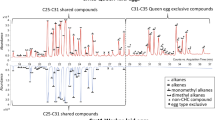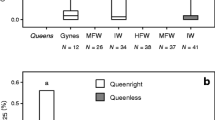Abstract
In ant societies, worker reproduction is regulated through policing behaviors, such as physical aggression or egg eating. The information used by policing individuals is thought to be in blends of hydrocarbons present on the cuticle and the surface of eggs. These fertility signals have been studied in numerous genera. However, signaling patterns that emerge across distinct subfamilies of ants have yet to be explained. We investigated policing behavior and the chemical signaling upon which policing behaviors are informed in the ant Aphaenogaster cockerelli. We found that worker-produced eggs are not policed, and we showed that there is a lack of chemical signaling for effective egg policing to occur in this species. Furthermore, we identified the available signals that demarcate workers to be policed physically. We showed that in A. cockerelli, a species with derived social organization, workers produce fertility signals identical to the queen. This queen-like signaling may be due to workers maintaining a high level of ovarian activity, linked to trophic egg production, in the presence of the queen.




Similar content being viewed by others
References
Arthur, C. L., and Pawliszyn, J. 1990. Solid-phase microextraction with thermal-desorption using fused-silica optical fibers. Anal. Chem. 62:2145–2148.
Bourke, A. F. G. 1988. Worker reproduction in the higher eusocial Hymenoptera. Q. Rev. Biol. 63:291–311.
Brian, M. V., and Rigby, C. 1978. Trophic eggs of Myrmica rubra L. Insectes Soc. 25:89–110.
Choe, J. C. 1988. Worker reproduction and social evolution in ants (Hymenoptera: Formicidae), pp. 163–187, in J. C. Trager (ed.). Advances in MyrmecologyLeiden, New York.
Cole, B. J. 1986. The social-behavior of Leptothorax allardycei (Hymenoptera, Formicidae)—time budgets and the evolution of worker reproduction. Behav. Ecol. Sociobiol. 18:165–173.
Cuvillier-Hot, V., Lenoir, A., Crewe, R., Malosse, C., and Peeters, C. 2004. Fertility signaling and reproductive skew in queenless ants. Anim. Behav. 68:1209–1219.
D’ettorre, P., Heinze, J., and Ratnieks, F. L. W. 2004. Worker policing by egg eating in the ponerine ant Pachycondyla inversa. Proc. R. Soc. Lond., Ser. B: Biol. Sci. 271:1427–1434.
Dietemann, V., Liebig, J., Hölldobler, B., and Peeters, C. 2005. Changes in the cuticular hydrocarbons of incipient reproductives correlate with triggering of worker policing in the bulldog ant Myrmecia gulosa. Behav. Ecol. Sociobiol. 58:486–496.
Dietemann, V., Peeters, C., Liebig, J., Thivet, V., and Hölldobler, B. 2003. Cuticular hydrocarbons mediate discrimination of reproductives and nonreproductives in the ant Myrmecia gulosa. Proc. Natl. Acad. Sci. U.S.A. 100:10341–10346.
Endler, A., Holldobler, B., and Liebig, J. 2007. Lack of physical policing and fertility cues in egg-laying workers of the ant Camponotus floridanus. Anim. Behav. 74:1171–1180.
Endler, A., Liebig, J., and Hölldobler, B. 2006. Queen fertility, egg marking and colony size in the ant Camponotus floridanus. Behav. Ecol. Sociobiol. 59:490–499.
Endler, A., Liebig, J., Schmitt, T., Parker, J. E., Jones, G. R., Schreier, P., and Hölldobler, B. 2004. Surface hydrocarbons of queen eggs regulate worker reproduction in a social insect. Proc. Natl. Acad. Sci. U.S.A. 101:2945–2950.
Hammond, R. L., and Keller, L. 2004. Conflict over male parentage in social insects. PLoS Biol. 2:1472–1482.
Hartmann, A., Wantia, J., Torres, J. A., and Heinze, J. 2003. Worker policing without genetic conflicts in a clonal ant. Proc. Natl. Acad. Sci. U.S.A. 100:12836–12840.
Helanterä, H., and Sundström, L. 2007. Worker policing and nest mate recognition in the ant Formica fusca. Behav. Ecol. Sociobiol. 61:1143–1149.
Hölldobler, B., and Carlin, N. 1989. Colony founding, queen control and worker reproduction in the ant Aphaenogaster (=Novomessor) cockerelli (Hymenoptera: Formicidae). Psyche 96:131–151.
Hölldobler, B., and Wilson, E. O. 1990. The Ants. Springer, Heidelberg, Germany.
Kikuta, N., and Tsuji, K. 1999. Queen and worker policing in the monogynous and monandrous ant, Diacamma sp. Behav. Ecol. Sociobiol. 46:180–189.
Le Conte, Y., and Hefetz, A. 2008. Primer pheromones in social Hymenoptera. Annu. Rev. Entomol. 53:523–542.
Liebig, J., Peeters, C., Oldham, N. J., Markstadter, C., and Hölldobler, B. 2000. Are variations in cuticular hydrocarbons of queens and workers a reliable signal of fertility in the ant Harpegnathos saltator? Proc. Natl. Acad. Sci. U.S.A. 97:4124–4131.
Lockey, K. H. 1988. Lipids of the insect cuticle—origin, composition and function. Comp. Biochem. Physiol. B: Biochem. Mol. Biol. 89:595–645.
Lommelen, E., Johnson, C. A., Drijfhout, F. P., Billen, J., Wenseleers, T., and Gobin, B. 2006. Cuticular hydrocarbons provide reliable cues of fertility in the ant Gnamptogenys striatula. J. Chem. Ecol. 32:2023–2034.
Monnin, T. 2006. Chemical recognition of reproductive status in social insects. Ann. Zool. Fenn. 43:515–530.
Monnin, T., Malosse, C., and Peeters, C. 1998. Solid-phase microextraction and cuticular hydrocarbon differences related to reproductive activity in queenless ant Dinoponera quadriceps. J. Chem. Ecol. 24:1423–1423.
Monnin, T., and Peeters, C. 1997. Cannibalism of subordinates’ eggs in the monogynous queenless ant Dinoponera quadriceps. Naturwissenschaften 84:499–502.
Monnin, T., and Ratnieks, F. L. W. 2001. Policing in queenless ponerine ants. Behav. Ecol. Sociobiol. 50:97–108.
Ratnieks, F. L. W. 1988. Reproductive harmony via mutual policing by workers in eusocial Hymenoptera. Am. Nat. 132:217–236.
Ratnieks, F. L. W., Foster, K. R., and Wenseleers, T. 2006. Conflict resolution in insect societies. Annu. Rev. Entomol. 51:581–608.
Smith, A. A., and Haight, K. L. 2008. Army ants as research and collection tools. J. Insect Sci. (in press).
Wenseleers, T., Helanterä, H., Hart, A., and Ratnieks, F. L. W. 2004. Worker reproduction and policing in insect societies: an ESS analysis. J. Evol. Biol. 17:1035–1047.
Acknowledgment
We thank Kevin Haight, Dani Moore, Clint Penick, and Dorit Eliyahu for assistance throughout the time this research was performed. C. T. Holbrook provided helpful comments on the manuscript.
Author information
Authors and Affiliations
Corresponding author
Rights and permissions
About this article
Cite this article
Smith, A.A., Hölldobler, B. & Liebig, J. Hydrocarbon Signals Explain the Pattern of Worker and Egg Policing in the Ant Aphaenogaster cockerelli . J Chem Ecol 34, 1275–1282 (2008). https://doi.org/10.1007/s10886-008-9529-9
Received:
Revised:
Accepted:
Published:
Issue Date:
DOI: https://doi.org/10.1007/s10886-008-9529-9




